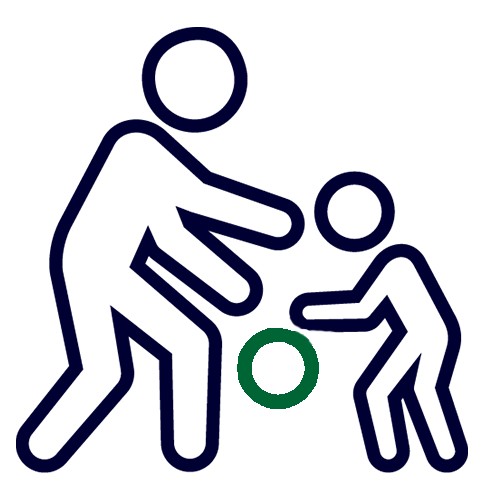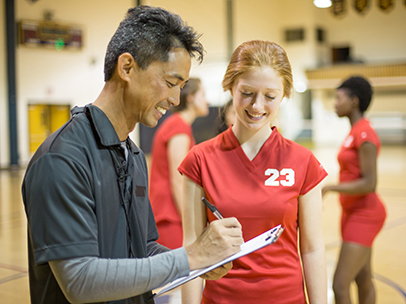SOCIAL AND MENTAL WELLBEING
THE ROLE OF SPORT
Research supporting the benefits of sport participation on a positive mental outlook is clear. Sport can play a valuable role in building mental health and connecting people to community.

BENEFITS OF SPORT FOR SPECIFIC POPULATIONS
CHALLENGES
Although there are many positive benefits to sport participation, lack of inclusion, poor behaviours and cultures can have negative impacts on participants. 47, 48, 49
Experiences of discrimination, harassment and abuse within sport in Australia have included verbal and physical abuse, as well as exclusion and silencing tactics. 50, 51, 52
Behaviour or attitudes that produce prejudice, exclusion, or harassment not only tarnish the reputation of individuals, but clubs and sport as a whole. These actions can be very hurtful and offensive to those who are targeted, causing depression, anxiety, and isolation. While some incidences are highly visible, the majority are never discussed.
There is a need for more research and resources to be made available to demonstrate the ways in which sport can have an effective and positive impact on the social and mental wellbeing of all participants, especially those who have higher risks of poor outcomes in this space.
As more institutions, coaching associations, and sport governing organisations adopt inclusive, non-discriminatory policies and implement awareness and educational programs for staff, athletes and fans, the climate will change. The result will be fewer cases of discrimination, harassment and abuse and a better sporting experience for everyone. 53, 54
- Understanding mental health and wellbeing, Everymind, (accessed 20 July 2022).
- National Study of Mental Health and Wellbeing: 2020-22, Australian Bureau of Statistics, (5 October 2023).
- Community Perceptions Monitor survey annual report 2021-22, Australian Sports Commission, (August 2022).
- Exercise makes you happier than money, according to Yale and Oxford research, Ruqayyah Moynihan, Business Insider Deutschland, (3 April 2019).
- Golfing regularly could be a hole-in-one for older adults’ health, Omar Saeed, and Fareed Suri, American Stroke Association International Stroke Conference – Poster Presentation TP172, Heart Foundation, (12 February 2020).
- Active and Healthy Ageing through Sport, van Uffelen J, Jenkin C, Westerbeek H, et al., Institute of Sport, Exercise and Active Living (ISEAL), Victoria University for the Australian Sports Commission, (2015).
- In Sport, We Trust: how sport can bridge the UK trust deficit, SPORTED, (2019).
- Yet another reason sport is good for you! Roy Morgan Research, Article 6118, (17 March 2015).
- A systematic review of the psychological and social benefits of participation in sport for children and adolescents: informing development of a conceptual model of health through sport, Eime R, Young J, Harvey J, et al., International Journal of Behavioral Nutrition and Physical Activity, Volume 10, article 135, (December 2013).
- The impact of sports participation on mental health and social outcomes in adults: a systematic review and the ‘Mental Health through Sport’ conceptual model, Narelle Eather, Levi Wade, Aurélie Pankowiak, Rochelle Eime, Systematic Reviews, Volume 12, article 102, (June 2023).
- Active Citizens Worldwide: annual report 2019, Active Citizens Worldwide, (2019).
- The value of community sport infrastructure: Investigating the value of community sport facilities to Australia, KPMG for the Australian Sports Commission, (2018).
- Sources of resilience and their moderating relationships with harms from adverse childhood experiences, Karen Hughes, Kat Ford, Alisha Davies, et al., Public Health Wales NHS Trust, (2018).
- Association of team sports participation with long-term mental health outcomes among individuals exposed to adverse dhildhood experiences, Easterlin MC, Chung PJ, Leng M, et al., JAMA Pediatrics, Volume 173(7), pp.681-688, (2019).
- Household Impacts of COVID-19 Survey: June 2021, Australian Bureau of Statistics, (14 July 2021).
- Mental Health Services in Australian, Australian Institute of Health and Welfare, (last updated 19 July 2022).
- Indigenous health and wellbeing, Australian Institute of Health and Welfare, (last updated 7 July 2022).
- People with disability in Australia, Australian Institute of Health and Welfare, (updated 5 July 2022).
- Exploring the association between sport participation and symptoms of anxiety and depression in a sample of Canadian high school students, Jessica Murphy, Karen Patte, Philip Sullivan, et al., Journal of Clinical Sport Psychology, Volume 15(3), pp.268-287, (September 2021).
- Childhood sport profiles predict mental health in adolescence, Isabelle Doré, Marie-Pierre Sylvestre, Catherine M Sabiston, et al., Conference paper presented at the International Journal of Behavioral Nutrition and Physical Activity conference, Hong Kong, (June 2018).
- Years participating in sports during childhood predicts mental health in adolescence: A 5-year longitudinal study, Isabelle Doré, Catherine M. Sabiston, Marie-Pierre Sylvestre, et al., Journal of Adolescent Health, Volume 64(6), pp.790-796, (June 2019).
- Organized sports in childhood linked to better emotional health in adolescence: study, Presse Canadienne, (9 June 2019).
- Consistent participation in organized physical activity predicts emotional adjustment in children, Frédéric Brière, Arianne Imbeault, Gary Goldfield, et al., Pediatric Research, Volume 88, pp.125-130, (2020).
- School Sport Participation During Adolescence and Mental Health in Early Adulthood, Rachel Jewett, Catherine Sabiston, Jennifer Brunet, et al., Journal of Adolescent Health, Volume 55(5), pp.640-644, (November 2014).
- Volunteering is good for us and the community! Office for Recreation, Sport and Racing, Government of South Australia, (2020).
- Sport and Social Capital, Australian Bureau of Statistics, (27 March 2012).
- Volunteers in Victoria: trends, challenges and opportunities, State of Victoria, Ministerial Council for Volunteers, (June 2017).
- Organized sport trajectories from childhood to adolescence and health associations, Howie E, McVeigh J, Smith A, Medicine and Science in Sports and Exercise, Volume 47(7), pp.1331-1339, (July 2016).
- Australian Indigenous youth's participation in sport and associated health outcomes: Empirical analysis and implications, Dalton B, Wilson R, Evans J, and Cochrane S, Sport Management Review, Volume 18(1), pp.57-68,(2015).
- After the Siren: The community benefits of Indigenous participation in Australia Rules Football. Michael Dockery and Sean Gorman, Bankwest Curtin Economics Centre, (September 2017).
- Sport and Settlement, Settlement Council of Australia, (2012).
- “We wouldn’t of made friends if we didn’t come to Football United”: the impacts of a football program on young people’s peer, prosocial and cross-cultural relationships, Sally Nathan, Lynn Kemp, Anne Bunde-Birouste, et.al., BMC Public Health, (27 April 2013).
- Integration into and through sports? Sport-activities for migrant children and youths, Karin Flensner, Peter Korp, Eva-Carin Lindgren, European Journal of Sport and Society, Volume 18(1), pp.64-81, (2021).
- Volunteering inclusion for people from CALD backgrounds, Carissa Jedwab, Volunteering Australia, (July 2023).
- Adaptive Sports Found to Help Children With Disabilities After One Season, Yale School of Medicine, (5 September 2019).
- Parents’ Perspectives on Adaptive Sports in Children with Profound Intellectual and Multiple Disabilities, Marion Neyroud and Christopher Newman, children, Volume 8(9), (September 2021).
- Youth participation in a wheelchair tennis program from a social relational perspective, Michelle Grenier, Aija Klavina, Lauren Lieberman, et.al., Sport Education and Society, (January 2022).
- Sports Participation, Physical Activity, and Health-Related Fitness in Youth With Chronic Diseases or Physical Disabilities: The Health in Adapted Youth Sports Study, Lankhorst, Kristel; Takken, Tim; Zwinkels, Maremka, et.al., Journal of Strength and Conditioning Research, Volume 35(8), pp.2327-2337, (August 2021).
- Player and Parent Experiences with Child and Adolescent Power Soccer Sport Participation, Elaine Bragg, Nancy Spencer, Shanon Phelan, Physical and Occupational Therapy in Pediatrics, Volume 40(6), pp.637-650, (April 2020).
- Effectiveness of surf therapy for children with disabilities, Emily Clapham, Linda Lamont, Minsuk Shim, et.al., Disability and Health Journal, Volume 13(1), 100828, (January 2020).
- ‘A level playing field’: Young people's experiences of wheelchair basketball as an enabling place, Bates Laura, Kearns Robin, Witten Karen, et.al., Health and Place, Volume 60, 102192, (November 2019).
- Self-Perceived Psychophysical Well-Being of Young Competitive Swimmers With Physical or Intellectual Impairment, Luca Puce, Lucio Marinelli, Nicola G. Girtler, et.al., Perceptual and Motor Skills, Volume 126(5), pp.862-885, (October 2019).
- Bone quality in young adults with intellectual disability involved in adapted competitive football, Vicente Lizondo, Jordi Caplliure-Llopis, Dolores Escrivá, et.al., European Journal of Sport Science, Volume 19(6), pp.850-859, (2019).
- Associations of sport participation with self-perception, exercise self-efficacy and quality of life among children and adolescents with a physical disability or chronic disease—a cross-sectional study, Saskia J. te Velde, Kristel Lankhorst, Maremka Zwinkels, et.al., Sports Medicine - Open, Volume 4, article number: 38, (August 2018).
- Young Athletes Program: Impact on Motor Development, Paddy Favazza, Gary Siperstein, Susan Zeisel, et.al., Adapted Physical Activity Quarterly, Volume 30(3), pp.235-253, (2013).
- Developing the social skills of young adult Special Olympics athletes, Alexander M, Smeltzer A, Dummer G and Denton, Education and Training in Autism and Developmental Disabilities, Volume 46(2), pp.297.310, (2011).
- The experiences of children participating in organised sport in the UK, Kate Alexander, Anne Stafford, Ruth Lewis, Child Protection Research Centre, University of Edinburgh (October 2011).
- Infographic. A guide to understanding athlete abuse, Tuakli-Wosornu YA, British Journal of Sports Medicine, Volume 55(24), pp.1439-1440, (December 2021).
- Lifetime Prevalence of Verbal, Physical, and Sexual Abuses in Young Elite Athletics Athletes, Stéphane Bermon, Paolo Emilio Adami, Örjan Dahlström, et.al., Frontiers in Sports and Active Living, (31 May 2021).
- Summary for Australia on Homophobia in Sport, (2015).
- The impact of homophobic bullying during sport and physical education participation on same-sex-attracted and gender-diverse young Australians’ depression and anxiety levels, Symons C, O’Sullivan G, Borkoles E, et.al., Institute for Sport, Exercise and Active Living (ISEAL), Victoria University (2014).
- LGBT+ Inclusion in Football in Victoria, Proud2Play for Football Victoria and VicHealth, (March 2020).
- The IOC Consensus Statement: harassment and abuse (non-accidental violence) in sport, Mountjoy M, Brackenridge C, Arrington M, et.al., British Journal of Sports Medicine, Volume 50(17), pp.1019-1029, (August 2016).
- Universal Code of Conduct to Prevent and Address Maltreatment in Sport (UCCMS), version 5.1, (2020).
RELATED TOPICS
Discover more about the value and benefits of sport.
Last updated: 29 November 2022
Content disclaimer: See Clearinghouse for Sport disclaimer
IS THIS INFORMATION COMPLETE?
The Clearinghouse for Sport is a sector-wide knowledge sharing initiative, and as such your contributions are encouraged and appreciated. If you would like to suggest a resource, submit a publication, or provide feedback on this topic, please contact us.
Alternatively, if you would like to be kept up to date with research and information published about this topic, please request a research profile setup.





